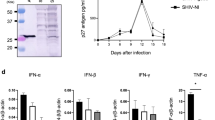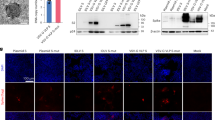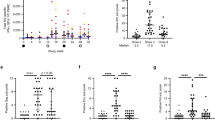Abstract
An effective immune response against human immunodeficiency virus or simian immunodeficiency virus (SIV) is critical in achieving control of viral replication. Here, we show in SIV-infected rhesus monkeys that an effective and durable SIV-specific cellular and humoral immunity is elicited by a vaccination with chemically inactivated SIV-pulsed dendritic cells. After three immunizations made at two-week intervals, the animals exhibited a 50-fold decrease of SIV DNA and a 1,000-fold decrease of SIV RNA in peripheral blood. Such reduced viral load levels were maintained over the remaining 34 weeks of the study. Molecular and cellular analyses of axillary and inguinal node lymphocytes of vaccinated monkeys revealed a correlation between decreased SIV DNA and RNA levels and increased SIV-specific T-cell responses. Neutralizing antibody responses were augmented and remained elevated. Inactivated whole virus-pulsed dendritic cell vaccines are promising means to control diseases caused by immuno- deficiency viruses.
This is a preview of subscription content, access via your institution
Access options
Subscribe to this journal
Receive 12 print issues and online access
$209.00 per year
only $17.42 per issue
Buy this article
- Purchase on Springer Link
- Instant access to full article PDF
Prices may be subject to local taxes which are calculated during checkout





Similar content being viewed by others
References
Kostense, S. et al. Persistent numbers of tetramer(+) CD8(+) T cells, but loss of interferon-γ(+) HIV-specific T cells during progression to AIDS. Blood 99, 2505–2511 (2002).
Barouch, D.H. et al. Eventual AIDS vaccine failure in a rhesus monkey by viral escape from cytotoxic T lymphocytes. Nature 415, 335–339 (2002).
Lieberman, J., Shankar, P., Manjunath, N. & Andersson, J. Dressed to kill? A review of why antiviral CD8 T lymphocytes fail to prevent progressive immunodeficiency in HIV-1 infection. Blood 98, 1667–1677 (2001).
Champagne, P. et al. Skewed maturation of memory HIV-specific CD8 T lymphocytes. Nature 410, 106–111 (2001).
Cohen, O.J., Kinter, A. & Fauci, A.S. Host factors in the pathogenesis of HIV disease. Immunol. Rev. 159, 31–48 (1997).
Fenyo, E.M. & Putkonen, P. Broad cross-neutralizing activity in serum is associated with slow progression and low risk of transmission in primate lentivirus infections. Immunol. Lett. 51, 95–99 (1996).
Knight, S.C. & Stagg, A.J. Antigen-presenting cell types. Curr. Opin. Immunol. 5, 374–382 (1993).
Rossio, J.L. et al. Inactivation of human immunodeficiency virus type 1 infectivity with preservation of conformational and functional integrity of virion surface proteins. J. Virol. 72, 7992–8001 (1998).
Buseyne, F. et al. MHC-I-restricted presentation of HIV-1 virion antigens without viral replication. Nature Med. 7, 344–349 (2001).
Mehlhop, E. et al. Enhanced in vitro stimulation of rhesus macaque dendritic cells for activation of SIV-specific T cell responses. J. Immunol. Methods 260, 219–234 (2002).
Sapp, M. et al. Dendritic cells generated from blood monocytes of HIV-1 patients are not infected and act as competent antigen presenting cells eliciting potent T-cell responses. Immunol. Lett. 66, 121–128 (1999).
Chougnet, C. et al. Normal immune function of monocyte-derived dendritic cells from HIV-infected individuals: implications for immunotherapy. J. Immunol. 163, 1666–1673 (1999).
Lu, W., Achour, A., Arlie, M., Cao, L. & Andrieu, J.M. Enhanced dendritic-cells-driven proliferation and anti-HIV activity of CD8+ T cells by a new phenothiazine derivative aminoperazine. J. Immunol. 167, 2929–2935 (2001).
Lu, W. & Andrieu, J.M. In vitro HIV eradication by autologous CD8+ T cells expanded with inactivated-virus-pulsed dendritic cells. J. Virol. 75, 8949–8956 (2001).
Hirsch, V.M. & Lifson, J.D. Simian immunodeficiency virus infection of monkeys as a model system for the study of AIDS pathogenesis, treatment, and prevention. Adv. Pharmacol. 49, 437–477 (2000).
Lu, W., Cao, L., Ty, L., Arlie, M. & Andrieu, J.M. Equivalent amplification of intrinsically variable nucleic acid sequences by multiple-primer-induced overlapping amplification assay: applications for universal detection and quantitation. Nature Med. 5, 1081–1085 (1999).
Nair, S.K. et al. Induction of primary carcinoembryonic antigen (CEA)-specific cytotoxic T lymphocytes in vitro using human dendritic cells transfected with RNA. Nature Biotechnol. 16, 364–369 (1998).
Salerno-Goncalves, R., Lu, W. & Andrieu, J.M. Quantitative analysis of the antiviral activity of CD8(+) T cells from human immunodeficiency virus-positive asymptomatic patients with different rates of CD4(+) T-cell decrease. J. Virol. 74, 6648–6651 (2000).
Lu, W. & Andrieu, J.M. Prospective views of HIV pathology. Clues for therapeutic strategies. Adv. Exp. Med. Biol. 374, 235–242 (1995).
Andrieu, J.M. & Lu, W. Viro-immunopathogenesis of HIV disease: implications for therapy. Immunol. Today 16, 5–7 (1995).
Hermans, I.F., Ritchie, D.S., Yang, J., Roberts, J.M. & Ronchese, F. CD8+ T cell-dependent elimination of dendritic cells in vivo limits the induction of antitumor immunity. J. Immunol. 164, 3095–3101 (2000).
Norbury, C.C., Malide, D., Gibbs, J.S., Bennink, J.R. & Yewdell, J.W. Visualizing priming of virus-specific CD8+ T cells by infected dendritic cells in vivo. Nature Immunol. 3, 265–271 (2002).
McIlroy, D. et al. Low CD83, but normal MHC class II and costimulatory molecule expression, on spleen dendritic cells from HIV+ patients. AIDS Res. Hum. Retroviruses 14, 505–513 (1998).
Zimmer, M.I. et al. Disrupted homeostasis of Langerhans cells and interdigitating dendritic cells in monkeys with AIDS. Blood 99, 2859–2868 (2002).
Ludewig, B. et al. Protective antiviral cytotoxic T cell memory is most efficiently maintained by restimulation via dendritic cells. J. Immunol. 163, 1839–1844 (1999).
Jin, X. et al. An antigenic threshold for maintaining human immunodeficiency virus type 1-specific cytotoxic T lymphocytes. Mol. Med. 6, 803–809 (2000).
Kalams, S.A. et al. Levels of human immunodeficiency virus type 1-specific cytotoxic T-lymphocyte effector and memory responses decline after suppression of viremia with highly active antiretroviral therapy. J. Virol. 73, 6721–6728 (1999).
Gray, C.M. et al. Frequency of class I HLA-restricted anti-HIV CD8+ T cells in individuals receiving highly active antiretroviral therapy (HAART). J. Immunol. 162, 1780–1788 (1999).
Pacanowski, J. et al. Reduced blood CD123+ (lymphoid) and CD11c+ (myeloid) dendritic cell numbers in primary HIV-1 infection. Blood 98, 3016–3021 (2001).
Feldman, S. et al. Decreased interferon-α production in HIV-infected patients correlates with numerical and functional deficiencies in circulating type 2 dendritic cell precursors. Clin. Immunol. 101, 201–210 (2001).
Donaghy, H. et al. Loss of blood CD11c(+) myeloid and CD11c(−) plasmacytoid dendritic cells in patients with HIV-1 infection correlates with HIV-1 RNA virus load. Blood 98, 2574–2576 (2001).
Grassi, F. et al. Depletion in blood CD11c-positive dendritic cells from HIV-infected patients. Aids 13, 759–766 (1999).
Grabar, S. et al. Clinical outcome of patients with HIV-1 infection according to immunologic and virologic response after 6 months of highly active antiretroviral therapy. Ann. Intern. Med. 133, 401–410 (2000).
Lederman, M.M. & Valdez, H. Immune restoration with antiretroviral therapies: implications for clinical management. JAMA 284, 223–228 (2000).
Hatano, H. et al. Pre-HAART HIV burden approximates post-HAART viral levels following interruption of therapy in patients with sustained viral suppression. Aids 14, 1357–1363 (2000).
Davey, R.T. Jr. et al. HIV-1 and T cell dynamics after interruption of highly active antiretroviral therapy (HAART) in patients with a history of sustained viral suppression. Proc. Natl. Acad. Sci. USA 96, 15109–15114 (1999).
Lu, W. & Andrieu, J.M. HIV protease inhibitors restore impaired T-cell proliferative response in vivo and in vitro: a viral-suppression-independent mechanism. Blood 96, 250–258 (2000).
Acknowledgements
We thank L. Cao, W. Deng, D. Han, H. Luo, J. Ma, S. Yang, J. Yuan, F. Zhang, W. Zhang, J. Zeng and Y. Zhou for assistance, and Air France for its prestige travel assistance. This study was supported by the Institut de Recherche sur les Vaccins et l'Immunothérapie des Cancers et du Sida (IRVICS).
Author information
Authors and Affiliations
Corresponding author
Ethics declarations
Competing interests
The authors declare no competing financial interests.
Rights and permissions
About this article
Cite this article
Lu, W., Wu, X., Lu, Y. et al. Therapeutic dendritic-cell vaccine for simian AIDS. Nat Med 9, 27–32 (2003). https://doi.org/10.1038/nm806
Received:
Accepted:
Published:
Issue Date:
DOI: https://doi.org/10.1038/nm806
This article is cited by
-
Evidence of a tolerogenic vaccine against AIDS in the Chinese macaque prefigures a potential human vaccine
Archives of Virology (2021)
-
A 30-year journey of trial and error towards a tolerogenic AIDS vaccine
Archives of Virology (2018)
-
SIV infection of rhesus macaques of Chinese origin: a suitable model for HIV infection in humans
Retrovirology (2013)
-
A cure for AIDS: a matter of timing?
Retrovirology (2013)
-
Can immunotherapy be useful as a “functional cure” for infection with Human Immunodeficiency Virus-1?
Retrovirology (2012)



